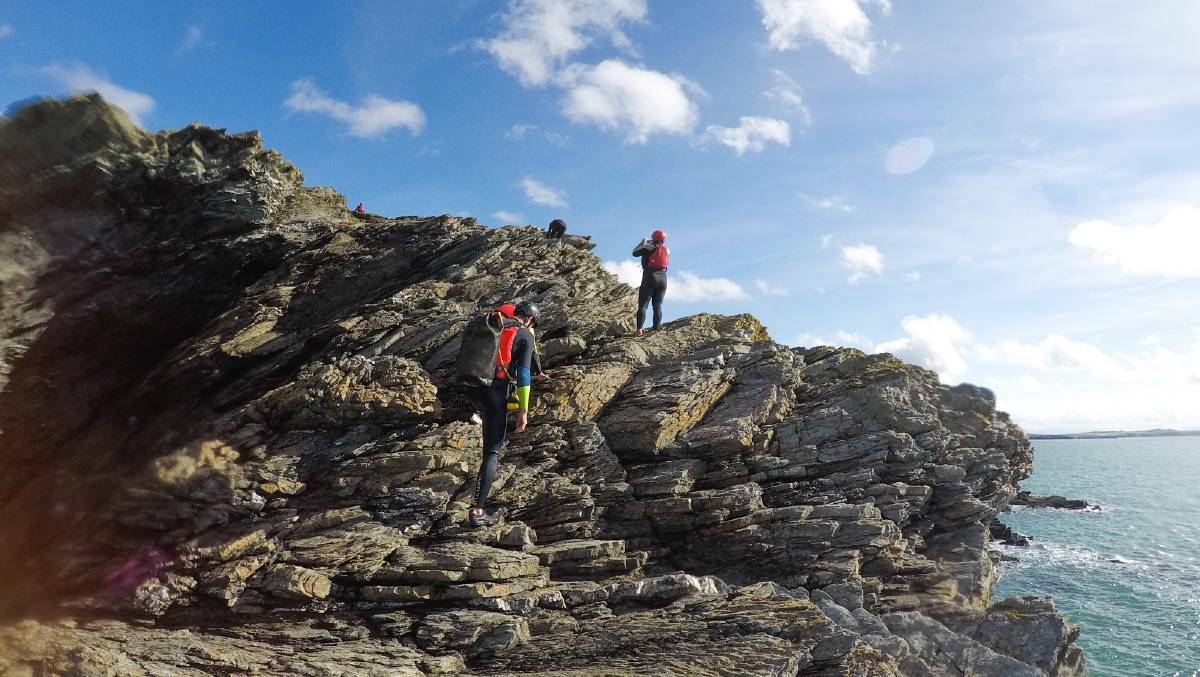Lying on the surfboard, I quickly glance behind me to see the wave approaching. I’ve never been any good at this, so I run through the steps my instructor has just given me as I begin to feel the board move: paddle, push up, left foot forward, right foot … what do I do with my right foot? I remember just as it’s too late and I crash sideways into the water.
For someone who grew up quite close to Bondi, I’m getting my surfing lessons not just late in life, but in the most unlikely of places. I’m not even at the beach, but about 10 kilometres inland at a pool with artificial waves … in a rural part of Wales!
The pool at Surf Snowdonia feels enormous – about the size of the SCG – with large blades that are pulled through the middle to create a wave across the whole width of the pool in one direction and then the other as they are pulled back. Dozens of people can catch each wave at different points – I and my fellow beginners are at the tail end, where we have a relatively easy run into the sand bank at the end.
I would never have thought that I would end up in the water in Wales, a country better known for its castles (the ones built by King Edward I here are astonishing), brooding mountains, and a town with a ridiculously long name (Llanfairpwllgwyngyllgogerychwyrndrobwllllantysiliogogogoch). But it’s actually just one of the times I end up in a wetsuit on this trip. The next day I find myself again dressed in Neoprene (and a helmet and life jacket) as I stand on the edge of a cliff, working up the courage to jump into the choppy waters of the Irish Sea.
At first, I’m more worried about the temperature than the rocks below – Wales is not known for its tepid water. But after the initial shock of cold, I find myself getting into the spirit of things as I scramble over rocks, climb up cliffs, jump into the water again, and swim to the next outcrop. This rather unusual sport is a Welsh invention called ”coasteering” that feels a bit like extreme rockpooling. It can be as easy or as difficult as you want but, at its core, it treats the rocky foreshore as an ecoadventure playground.
What started as an activity for youngsters in the 1980s has now become a popular experience for tourists to the region – and an important part of a wider push by Wales to market itself to visitors as an adventure destination. In recent years, the small nation has seen a number of extreme sports hold championship events here, and the number of international visitors coming for adventure activities is increasing.

Across the country, you can find new centres that have been built to cater for these thrill-seekers. I find myself staring down at one of them as I get strapped in at the very top of ”Velocity 2”, the fastest zip line in the world. There’s something a bit scary about looking at the old quarry below, knowing that I’m about to be whizzing through the air above it at about 160km/h, attached to just a thin metal cable. But when I’m released and the zip begins (thank goodness I didn’t have to launch myself off the platform or I would probably still be there) the speed is exhilarating and I feel like I’m flying along the 1.5-kilometre line.
The same company that operates Velocity 2, Zip World, has other sites through Wales with smaller zip lines, treetop climbing courses, toboggan tracks, and even a huge bouncing net underground in a disused mine. Plus, there is no shortage of opportunities throughout the country for activities like cycling, kayaking, hang gliding, and rock climbing.

Despite – or maybe because of – the focus on extreme sport in Wales these days, one of the most traditional outdoor Welsh activities, hiking, is as popular as ever. And there’s no better walk than up the dramatic peak of Mount Snowdon, which gives its name to the famous Snowdonia National Park. At 1085 metres, it may be the highest mountain in the nation, but doesn’t normally rate a mention amongst enormous international peaks. Now, though, it seems to have gained a prestige reputation with international hikers. There are six different routes you can take to the top and the easiest is just a round trip of 14.5 kilometres that takes about six hours.

But not every walk needs to be extreme and Wales has recently developed an option for those who want a more horizontal adventure. The Wales Coast Path opened in 2012 and gives you an uninterrupted route along the entire coast of Wales – all 1400 kilometres of it! While few people may have the time to walk the whole path, there are some great stretches you can do in a day or over a few days.
Some parts of the Wales Coast Path will even take walkers past iconic Welsh sights, including the four castles of King Edward I that make up a World Heritage Site (Conwy Castle being the most spectacular of them, and Caernarfon Castle particularly famous as the site of the investiture of the Prince of Wales).

Trying some sections of the coastal path (unfortunately I don’t have the time to do it all), I see each of these castles. It seems that even would-be adventurers and thrill-seekers can’t escape the heritage and the landscapes of Wales – which, to my mind, is even more of a reason for visitors to embrace this new tourism direction. There’s something surprisingly natural about the extreme here.




